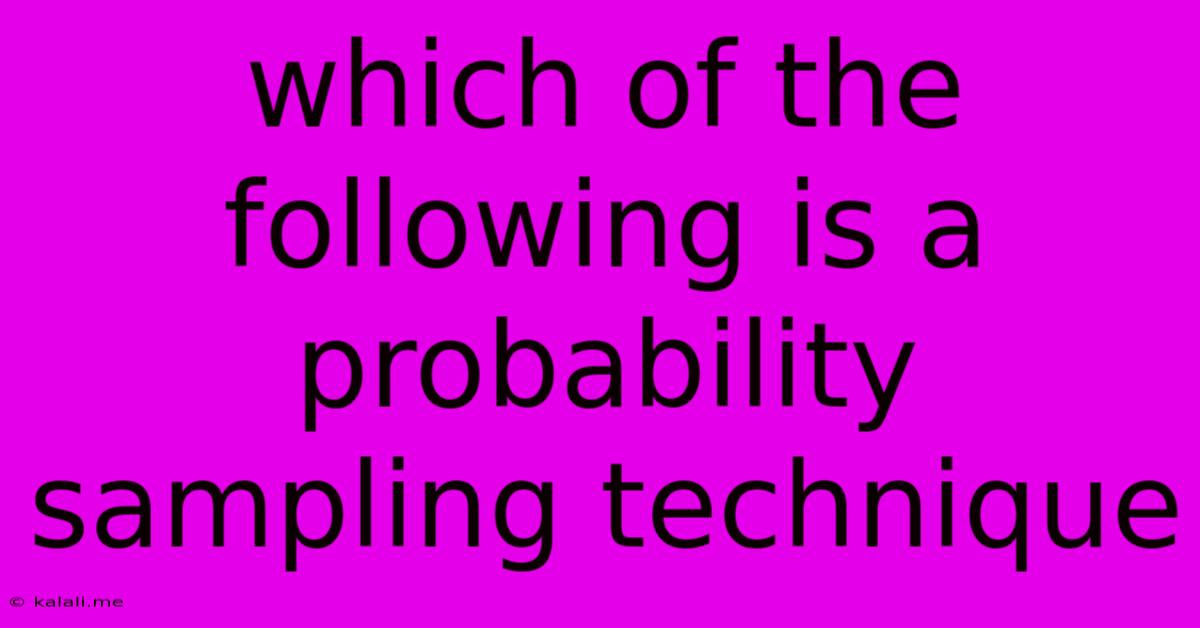Which Of The Following Is A Probability Sampling Technique
Kalali
Jun 15, 2025 · 3 min read

Table of Contents
Which of the Following is a Probability Sampling Technique? Understanding Probability vs. Non-Probability Sampling
Choosing the right sampling technique is crucial for conducting reliable research. This article will clarify the difference between probability and non-probability sampling, focusing specifically on identifying which methods fall under the probability umbrella. Understanding this distinction ensures the validity and generalizability of your research findings. We'll explore several key probability sampling techniques and explain why they are preferred for generating statistically sound results.
Probability sampling, at its core, is a sampling method where each member of the population has a known, non-zero chance of being selected for the sample. This ensures that the sample is representative of the larger population, allowing researchers to make inferences about the entire group based on the findings from the sample. In contrast, non-probability sampling methods don't offer this guarantee, often leading to biased or skewed results. This makes probability sampling the gold standard for many research endeavors.
Key Probability Sampling Techniques
Several methods fall under the probability sampling umbrella. Here are some of the most commonly used:
-
Simple Random Sampling: This is the most straightforward technique. Every member of the population has an equal and independent chance of being selected. Imagine drawing names from a hat – each name has the same probability of being chosen. This method is easy to understand and implement but might not be the most efficient for large or diverse populations.
-
Stratified Random Sampling: This technique divides the population into subgroups (strata) based on shared characteristics (e.g., age, gender, income). A random sample is then drawn from each stratum, ensuring representation from all segments of the population. This method is particularly useful when you need to ensure representation from specific subgroups, improving the accuracy and precision of your results.
-
Cluster Sampling: This involves dividing the population into clusters (e.g., geographic areas, schools) and randomly selecting entire clusters to participate in the study. It is especially useful for large populations spread over a wide geographic area, reducing the costs and logistical challenges associated with sampling.
-
Systematic Sampling: This method selects members of the population at regular intervals. For example, if you have a population of 1000 and want a sample of 100, you could select every 10th person. While seemingly simple, it's crucial to ensure that the population list is randomly ordered to avoid biases.
-
Multistage Sampling: This is a complex technique that combines different probability sampling methods. It often involves selecting clusters at multiple stages. For example, you might first randomly select states, then randomly select counties within those states, and finally randomly select individuals within the chosen counties. This method is highly effective for studying large, diverse populations efficiently.
Why Probability Sampling is Important
The significance of using probability sampling lies in its ability to minimize sampling bias and allow for the generalization of findings to the larger population. Non-probability sampling techniques, such as convenience sampling or purposive sampling, are susceptible to bias, making it difficult to draw reliable conclusions about the population as a whole. The known probability of selection in probability sampling allows researchers to calculate sampling error and make statistically valid inferences. This is crucial for drawing credible conclusions and making informed decisions based on the research findings.
Conclusion
Probability sampling techniques, including simple random, stratified, cluster, systematic, and multistage sampling, are essential tools for researchers seeking to collect representative and unbiased data. Understanding the nuances of each method allows for the selection of the most appropriate technique for a given research question and population, ultimately leading to more robust and reliable results. The strength of probability sampling lies in its ability to minimize bias and allow for confident generalization of findings to the broader population, making it the preferred approach for many research studies.
Latest Posts
Latest Posts
-
Carpentry Different Types Of Hand Planes
Jun 16, 2025
-
Least Common Multiple Of 3 6 And 9
Jun 16, 2025
-
The Si Unit Of Resistance Is The
Jun 16, 2025
-
Explain The Difference Between Rotation And Revolution
Jun 16, 2025
-
Choose The Statements That Are True About Zinc
Jun 16, 2025
Related Post
Thank you for visiting our website which covers about Which Of The Following Is A Probability Sampling Technique . We hope the information provided has been useful to you. Feel free to contact us if you have any questions or need further assistance. See you next time and don't miss to bookmark.